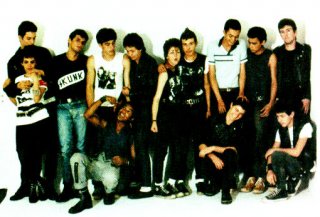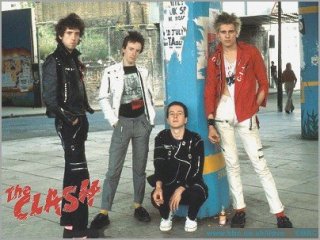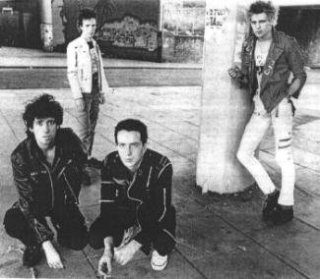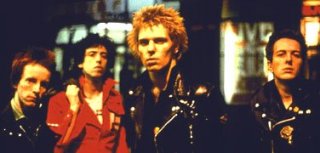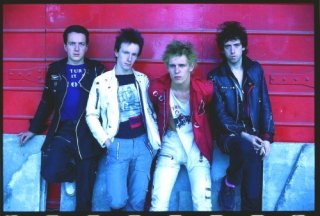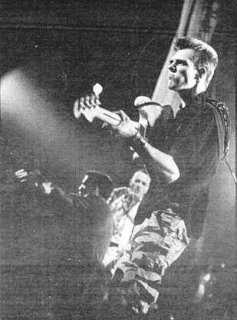-
Announcing... The 3rd annual theFashionSpot Awards for 2025. Vote NOW via the links below:
Designer of the Year
Ready-to-Wear Collection of the Year
Haute Couture Collection of the Year
Model of the Year
Photographer of the Year
Stylist of the Year
Magazine Cover of the Year
Ad Campaign of the Year
Thank you for participating!
VOTING WILL CLOSE 29/12/2025 EOD!
You are using an out of date browser. It may not display this or other websites correctly.
You should upgrade or use an alternative browser.
You should upgrade or use an alternative browser.
Punk
- Thread starter Caroline
- Start date
Lena said:*dare say that with the current global socio/economic situation, punk -or a fresh kind of punk- is expected to rise soon, hopefully in a new esthetic format
I so agree with this Lena, i think may be it will take some time, but i could see with in the next 5-10 years a new movement emerging. Between the wars and the bad economies it seems like time.
Spacemiu said:I so agree with this Lena, i think may be it will take some time, but i could see with in the next 5-10 years a new movement emerging. Between the wars and the bad economies it seems like time.
it may take much less than that, walking down the streets in Paris or Berlin, with all those teens in their huge 'skirt pants' gave me the feeling..
they try to allienate as much as they can from a society which lets them
down and they want people to know, instantly. Esthetics are just used as a way of communicating the obvious, in this case a well commincated distance. works almost as a code.
The new 'version' of rebel dressing wont be easyly adapted by mom&dad, it seems too tough to market through a 'polished' label
needless to say
 hoods are a vital part of the new 'city guerilla' look
hoods are a vital part of the new 'city guerilla' look
Brazilian Girl
Active Member
- Joined
- Mar 15, 2005
- Messages
- 3,556
- Reaction score
- 2
this is a great topic....
you know, punk plays a really big part in my life. My dad was one of the guys who started the punk movement here in Brazil, he was one of the people who started the very first Brazilian punk band. So I was kinda born in the middle of this whole thing, and grew up in the middle of the Brazilian punk scene. Very fun, I must say. It's funny cause I know all these people who were very important to the Brazilian punk scene in the 80's and blah blah blah, but to me they're just family friends.
I have very lucky parents. I mean, my dad's band opened a Sex Pistols gig back in the 80's! And my mum was there! heh
And I guess I'm quite lucky as well... I mean, just last year I got to meet the guys of The Lurkers, a great band from Richmond - England that is very important in the British punk scene since 77. And since I was young I got to go to radio stations, TV studios, the MTV Brazil beach house (at the time MTV Brazil wasn't as mainstream as it is now) and all of that stuff.
I truly everything about punk, and it's so sad to see how it's being so commercialized these days.
everything about punk, and it's so sad to see how it's being so commercialized these days.
Here's a pic of my father and other Brazilian punks who were big back in the 80's (when the movement exploded here)
you know, punk plays a really big part in my life. My dad was one of the guys who started the punk movement here in Brazil, he was one of the people who started the very first Brazilian punk band. So I was kinda born in the middle of this whole thing, and grew up in the middle of the Brazilian punk scene. Very fun, I must say. It's funny cause I know all these people who were very important to the Brazilian punk scene in the 80's and blah blah blah, but to me they're just family friends.

I have very lucky parents. I mean, my dad's band opened a Sex Pistols gig back in the 80's! And my mum was there! heh
And I guess I'm quite lucky as well... I mean, just last year I got to meet the guys of The Lurkers, a great band from Richmond - England that is very important in the British punk scene since 77. And since I was young I got to go to radio stations, TV studios, the MTV Brazil beach house (at the time MTV Brazil wasn't as mainstream as it is now) and all of that stuff.
I truly
 everything about punk, and it's so sad to see how it's being so commercialized these days.
everything about punk, and it's so sad to see how it's being so commercialized these days.
Here's a pic of my father and other Brazilian punks who were big back in the 80's (when the movement exploded here)
Attachments
Last edited by a moderator:
Punk was initially a way of thinking, had nothing to do with the way they dressed (although YES, most punks do have that certain kind of style)....
It's ironic people start getting into it just for the rebel look, without even having half of an idea about the concept.
It's ironic people start getting into it just for the rebel look, without even having half of an idea about the concept.
Brazilian Girl
Active Member
- Joined
- Mar 15, 2005
- Messages
- 3,556
- Reaction score
- 2
^it sure is, I wish I was born by then!!
and I totally agree with what you said about people starting to get into it just for the rebel look. This kinda people just truly have no idea what punk is all about, but they wanna dress like punks cause it looks cool or something...
And here's a few pics of my favorite of all time... The Clash

and I totally agree with what you said about people starting to get into it just for the rebel look. This kinda people just truly have no idea what punk is all about, but they wanna dress like punks cause it looks cool or something...

And here's a few pics of my favorite of all time... The Clash

Attachments
The Clash are one of my all-time favourites!! I'm not really into punk music, but I love The Clash
And I also find ridiculous that people that knows nothing about punk and don't like punk music try to dress like a punk to look cool, real punks must be a bit annoyed with that.

And I also find ridiculous that people that knows nothing about punk and don't like punk music try to dress like a punk to look cool, real punks must be a bit annoyed with that.
softgrey
flaunt the imperfection
- Joined
- Jan 28, 2004
- Messages
- 52,984
- Reaction score
- 415
punk was about BOTH the music and the 'style'...
and what made it great then was that it was original and new...
in both areas....
and it was a way to make a 'social statement'...
to oppose the 'status quo'...
what's disappointing to me now is that the younger generation doesn't seem to have a 'movement' of their own...
like lena...i am ready for the next 'new' thing....
rather than just a re-hash of the eighties...
and i think it is somewhat overdue...
*i agree that 'hoodies' seem to be emerging as a big trend with that market...
and i think 'romanticism' is a part of it too...

and what made it great then was that it was original and new...
in both areas....
and it was a way to make a 'social statement'...
to oppose the 'status quo'...
what's disappointing to me now is that the younger generation doesn't seem to have a 'movement' of their own...
like lena...i am ready for the next 'new' thing....
rather than just a re-hash of the eighties...

and i think it is somewhat overdue...
*i agree that 'hoodies' seem to be emerging as a big trend with that market...
and i think 'romanticism' is a part of it too...

Last edited by a moderator:
as i stated before, i think the young generation have their own code dressing,
things that mon& dad wouldnt possibly dare to wear.. its inspired mainly from skate culture, but it sure is out there a developing, different kind of young 'anti-status quo' dress code...
if i was a kid today, i'd be certainly annoyed how 'adults' steal/adopt youth styles as soon as they are out in the market
go for it, bring in the 'new punk' guys and please let it be something 'fresh' and creative not just a reworked '80s bubblegum
things that mon& dad wouldnt possibly dare to wear.. its inspired mainly from skate culture, but it sure is out there a developing, different kind of young 'anti-status quo' dress code...
if i was a kid today, i'd be certainly annoyed how 'adults' steal/adopt youth styles as soon as they are out in the market
go for it, bring in the 'new punk' guys and please let it be something 'fresh' and creative not just a reworked '80s bubblegum

http://www.metmuseum.org/toah/hd/vivw/hd_vivw.htm
Vivienne Westwood was born Vivienne Isabel Swire in Glossop, Derbyshire, in 1941 and has come to be known as one of the most influential British fashion designers of the twentieth century. While she is latterly credited with introducing "underwear as outerwear," reviving the corset, and inventing the "mini-crini,"1 her earliest and most formative association is with the subcultural fashion and youth movement known as punk.2
Mother of Punk
Vivienne Westwood is often cited as punk's creator, but the complex genesis of punk is also found in England's depressed economic and sociopolitical conditions of the mid-1970s. Punk was as much a youthful reaction against older generations, considered oppressive and outdated, as a product of the newly recognized and influential youth culture. Creative and entrepreneurial people, such as Westwood, often contribute to an aesthetic that brings a subcultural style to the forefront of fashion. However, it would be simplistic to claim, as many have, that Westwood and her one-time partner Malcolm McClaren were uniquely responsible for the visual construction of punk in the mid-1970s, though much of their work captured and commodified the energy and iconoclastic tendencies of the movement.3
The New York Effect
In the early 1970s, the socioeconomics of New York City were no better than London's. Local rock groups were reinventing music and style in protest against what had become perceived as the star-centered, showy, and elitist mentality of '60s super-groups such as the Rolling Stones and the Beatles. These local bands, such as the New York Dolls and performer Richard Hell, were breaking down barriers at the infamous proto-punk club, Max's. Hell was well known for his nihilistic lyrics and wearing of self-styled ripped T-shirts bearing slogans like "Please Kill Me." The original fanzine of the era, PUNK, was published in New York City and is credited with the first use of the term. Malcolm McLaren, Westwood's boyfriend and "partner in crime," was living in New York during this time and briefly managed the New York Dolls. According to punk lore, McLaren took this radical New York aesthetic back to London, where he opened the SEX clothing shop with Westwood and managed the Sex Pistols, creating a media frenzy and a prosperous symbiotic relationship between music and fashion that effectively set the tone of popular culture for decades to come.
Anarchy in the U.K.
Westwood, a former schoolteacher, was the seamstress in the SEX shop partnership with McLaren and made manifest their combined punk vision through her creations. Westwood designed both her and McLaren's clothing before they opened their first store, Let It Rock, in 1971. Let It Rock catered to the "Teddy Boy" subculture, which was a 1950s revival look. In 1972, they renamed the store Too Fast to Live, Too Young to Die, and changed the focus to emphasize the emergence of the Marlon Brando-influenced rocker/biker style that was popular at the time. In 1974, they again changed the name of the shop to reflect McLaren's new shock tactics, this time to SEX, where they sold S&M (sado-masochistic) inspired clothing, met the Sex Pistols, and added their punk line, Seditionaries,4 in 1976.5 SEX was the center of the punk fashion scene and many young punks hung out, worked, or bought clothes there when they could afford them. Shrewd entrepreneurs, Westwood and McLaren were instrumental in defining and marketing the punk look at the precise moment that it was taking the streets of London by storm.
Rotten, Vicious Fashion
Childhood friends Johnny Rotten and Sid Vicious claim names that evoke the true essence of punk. The Sex Pistols, their short-lived and infamous band, changed the face of music and gave voice to a disenfranchised generation. The Sex Pistols were working-class, antagonistic, innovative teenagers turned "punk" before it had a name.6 The clothing popularized by the Sex Pistols could be seen as a reaction against, as well as the culmination of, a long line of proscribed postwar British subcultural styles, including mods, skinheads, rastas, and rudies.
The Sex Pistols needed a manager to guide them and McLaren and Westwood needed an outlet for their ideas, both fashionable and political. To this day, there is much debate about whether McLaren was the architect of punk ideology. A known Situationist,7 McLaren supposedly created the Sex Pistols solely as a marketing tool for the SEX shop, but singer Johnny Rotten disputes this, emphasizing that the band existed prior to the collaboration with Westwood and McClaren but were used as models for the ideal punk look through their stage clothes often supplied by SEX.8
Deconstructing Punk
[font=geneva,arial,sans-serif]Punk was trash culture gone avant-garde and/or the avant-garde gone trash, and just as Dada had tried to destroy the institution of art, so the punks seemed bent on destroying the very institution of fashion.9
[/font]
Philosopher Jacques Derrida's concept of "deconstruction," a term used to describe the process of uncovering the multiplicity of meanings in text, has been used to analyze everything from modern art to architecture. As applied to fashion, deconstruction has come to imply a decoding of both meaning and designer intent, as well as a descriptive term for certain structural characteristics.
The punk look has come to be associated with clothing that has been destroyed, has been put back together, is inside out, is unfinished, or is deteriorating.10 Punk was an early manifestation of deconstructionist fashion, which is an important component of late twentieth-century postmodern style and continues to be seen in the work of contemporary fashion designers such as Rei Kawakubo and Martin Margiela.
"A Nightmare of Interchangeable Surfaces"11
The definition of postmodern is elusive, but its connection to punk ideology and style appears intrinsic:
[font=geneva,arial,sans-serif]On the one hand, to designate oneself as "post" anything, is to admit a certain exhaustion, diminution or decay. Someone who inhabits a post-culture is a late comer to a party … Belatedness may also imply a certain dependence, for the post-culture cannot even define itself in any free-standing way, but is condemned to the parasitic prolongation of some vanished cultural achievement.12
[/font]
Many scholars see this incessant atavism, this self-referential bricolage, as precisely what defines the postmodern, a term frequently used to describe the designs of Vivienne Westwood and punk fashion in general. The do-it-yourself attitude of punk styling was a unique product of a particular sociocultural history after which, during the 1980s and '90s, global style continued to evolve along the same aesthetic trajectory. Other elements that have recently been associated with the postmodern mode include clothing and imagery that appear dirty, ripped, scarred, shocking, spectacular, cruel, traumatized, sick, or alienating13—all of these were qualities actively sought by Vivienne Westwood and the punks of the 1970s.
Postmodernism = No Future
Punk was both a product and a victim of late capitalism. As the most quickly digested of all previous youth subcultures, it came to fruition and fell victim to mass marketing in less than three years.14 Since then, punk has never entirely gone out of style. Soon after the Sex Pistols disbanded in 1978, one could see punks everywhere in London, the U.S., and elsewhere. One still sees flamboyant teenagers wearing bondage trousers and studded leather motorcycle jackets on streets such as St. Marks Place in New York City, where these garments are still sold in quantity. Punk has even taken more than one turn at being an inspiration for haute couture. In the twenty-first century, punk and hip-hop, another subcultural style born of strife, have been fused together into what has become the standard look for contemporary youth.
The Costume Institute's collection of Vivienne Westwood's early work pays homage to punk's influence and situates historically these authentic garments of a subcultural style that has few rivals in its continued influence on Western fashion's mavericks.
Vivienne Westwood was born Vivienne Isabel Swire in Glossop, Derbyshire, in 1941 and has come to be known as one of the most influential British fashion designers of the twentieth century. While she is latterly credited with introducing "underwear as outerwear," reviving the corset, and inventing the "mini-crini,"1 her earliest and most formative association is with the subcultural fashion and youth movement known as punk.2
Mother of Punk
Vivienne Westwood is often cited as punk's creator, but the complex genesis of punk is also found in England's depressed economic and sociopolitical conditions of the mid-1970s. Punk was as much a youthful reaction against older generations, considered oppressive and outdated, as a product of the newly recognized and influential youth culture. Creative and entrepreneurial people, such as Westwood, often contribute to an aesthetic that brings a subcultural style to the forefront of fashion. However, it would be simplistic to claim, as many have, that Westwood and her one-time partner Malcolm McClaren were uniquely responsible for the visual construction of punk in the mid-1970s, though much of their work captured and commodified the energy and iconoclastic tendencies of the movement.3
The New York Effect
In the early 1970s, the socioeconomics of New York City were no better than London's. Local rock groups were reinventing music and style in protest against what had become perceived as the star-centered, showy, and elitist mentality of '60s super-groups such as the Rolling Stones and the Beatles. These local bands, such as the New York Dolls and performer Richard Hell, were breaking down barriers at the infamous proto-punk club, Max's. Hell was well known for his nihilistic lyrics and wearing of self-styled ripped T-shirts bearing slogans like "Please Kill Me." The original fanzine of the era, PUNK, was published in New York City and is credited with the first use of the term. Malcolm McLaren, Westwood's boyfriend and "partner in crime," was living in New York during this time and briefly managed the New York Dolls. According to punk lore, McLaren took this radical New York aesthetic back to London, where he opened the SEX clothing shop with Westwood and managed the Sex Pistols, creating a media frenzy and a prosperous symbiotic relationship between music and fashion that effectively set the tone of popular culture for decades to come.
Anarchy in the U.K.
Westwood, a former schoolteacher, was the seamstress in the SEX shop partnership with McLaren and made manifest their combined punk vision through her creations. Westwood designed both her and McLaren's clothing before they opened their first store, Let It Rock, in 1971. Let It Rock catered to the "Teddy Boy" subculture, which was a 1950s revival look. In 1972, they renamed the store Too Fast to Live, Too Young to Die, and changed the focus to emphasize the emergence of the Marlon Brando-influenced rocker/biker style that was popular at the time. In 1974, they again changed the name of the shop to reflect McLaren's new shock tactics, this time to SEX, where they sold S&M (sado-masochistic) inspired clothing, met the Sex Pistols, and added their punk line, Seditionaries,4 in 1976.5 SEX was the center of the punk fashion scene and many young punks hung out, worked, or bought clothes there when they could afford them. Shrewd entrepreneurs, Westwood and McLaren were instrumental in defining and marketing the punk look at the precise moment that it was taking the streets of London by storm.
Rotten, Vicious Fashion
Childhood friends Johnny Rotten and Sid Vicious claim names that evoke the true essence of punk. The Sex Pistols, their short-lived and infamous band, changed the face of music and gave voice to a disenfranchised generation. The Sex Pistols were working-class, antagonistic, innovative teenagers turned "punk" before it had a name.6 The clothing popularized by the Sex Pistols could be seen as a reaction against, as well as the culmination of, a long line of proscribed postwar British subcultural styles, including mods, skinheads, rastas, and rudies.
The Sex Pistols needed a manager to guide them and McLaren and Westwood needed an outlet for their ideas, both fashionable and political. To this day, there is much debate about whether McLaren was the architect of punk ideology. A known Situationist,7 McLaren supposedly created the Sex Pistols solely as a marketing tool for the SEX shop, but singer Johnny Rotten disputes this, emphasizing that the band existed prior to the collaboration with Westwood and McClaren but were used as models for the ideal punk look through their stage clothes often supplied by SEX.8
Deconstructing Punk
[font=geneva,arial,sans-serif]Punk was trash culture gone avant-garde and/or the avant-garde gone trash, and just as Dada had tried to destroy the institution of art, so the punks seemed bent on destroying the very institution of fashion.9
[/font]
Philosopher Jacques Derrida's concept of "deconstruction," a term used to describe the process of uncovering the multiplicity of meanings in text, has been used to analyze everything from modern art to architecture. As applied to fashion, deconstruction has come to imply a decoding of both meaning and designer intent, as well as a descriptive term for certain structural characteristics.
The punk look has come to be associated with clothing that has been destroyed, has been put back together, is inside out, is unfinished, or is deteriorating.10 Punk was an early manifestation of deconstructionist fashion, which is an important component of late twentieth-century postmodern style and continues to be seen in the work of contemporary fashion designers such as Rei Kawakubo and Martin Margiela.
"A Nightmare of Interchangeable Surfaces"11
The definition of postmodern is elusive, but its connection to punk ideology and style appears intrinsic:
[font=geneva,arial,sans-serif]On the one hand, to designate oneself as "post" anything, is to admit a certain exhaustion, diminution or decay. Someone who inhabits a post-culture is a late comer to a party … Belatedness may also imply a certain dependence, for the post-culture cannot even define itself in any free-standing way, but is condemned to the parasitic prolongation of some vanished cultural achievement.12
[/font]
Many scholars see this incessant atavism, this self-referential bricolage, as precisely what defines the postmodern, a term frequently used to describe the designs of Vivienne Westwood and punk fashion in general. The do-it-yourself attitude of punk styling was a unique product of a particular sociocultural history after which, during the 1980s and '90s, global style continued to evolve along the same aesthetic trajectory. Other elements that have recently been associated with the postmodern mode include clothing and imagery that appear dirty, ripped, scarred, shocking, spectacular, cruel, traumatized, sick, or alienating13—all of these were qualities actively sought by Vivienne Westwood and the punks of the 1970s.
Postmodernism = No Future
Punk was both a product and a victim of late capitalism. As the most quickly digested of all previous youth subcultures, it came to fruition and fell victim to mass marketing in less than three years.14 Since then, punk has never entirely gone out of style. Soon after the Sex Pistols disbanded in 1978, one could see punks everywhere in London, the U.S., and elsewhere. One still sees flamboyant teenagers wearing bondage trousers and studded leather motorcycle jackets on streets such as St. Marks Place in New York City, where these garments are still sold in quantity. Punk has even taken more than one turn at being an inspiration for haute couture. In the twenty-first century, punk and hip-hop, another subcultural style born of strife, have been fused together into what has become the standard look for contemporary youth.
The Costume Institute's collection of Vivienne Westwood's early work pays homage to punk's influence and situates historically these authentic garments of a subcultural style that has few rivals in its continued influence on Western fashion's mavericks.
fourboltmain
More Old Skool Than You
- Joined
- Oct 31, 2004
- Messages
- 4,160
- Reaction score
- 4
I'm going to go out on a limb and say GG Allin was the original punk. And those leather jackets didn't become the punk uniform until Sid Vicious came about, by then the scene was already established. I'm more into the original hardcore style of dress, like early Henry Rollins, Black Flag, kind of Suicidal Tendencies kind of style.
Last edited by a moderator:
welcome kimkhuu

[font=geneva,arial,sans-serif]"Bondage" suit, 1976
Vivienne Westwood (British, born 1941); Malcolm McLaren (British, born 1946)
Black cotton with metal fittings
Purchase, Irene Lewisohn Bequest, 2003 (2004.15a,b)
"Bondage" pants, late 1970s
Vivienne Westwood (British, born 1941); Malcolm McLaren (British, born 1946)
Black cotton sateen with two-piece matching black wool over-kilt
Purchase, Richard Martin Bequest, 2003 (2003.479a–c)
http://www.metmuseum.org/toah/hd/vivw/ho_2004.15a,b.htm[/font]

[font=geneva,arial,sans-serif]"Bondage" suit, 1976
Vivienne Westwood (British, born 1941); Malcolm McLaren (British, born 1946)
Black cotton with metal fittings
Purchase, Irene Lewisohn Bequest, 2003 (2004.15a,b)
"Bondage" pants, late 1970s
Vivienne Westwood (British, born 1941); Malcolm McLaren (British, born 1946)
Black cotton sateen with two-piece matching black wool over-kilt
Purchase, Richard Martin Bequest, 2003 (2003.479a–c)
http://www.metmuseum.org/toah/hd/vivw/ho_2004.15a,b.htm[/font]
AlmostFamous
Active Member
- Joined
- Feb 23, 2003
- Messages
- 3,356
- Reaction score
- 6
I enjoyed this, a lot. Awesome posts, all of you!! 

isupporthil
Member
- Joined
- May 18, 2005
- Messages
- 983
- Reaction score
- 0
My fav punk band is The Libertines with Pete Doherty, Kate Moss' boyfriend !!! I looooove their music!!


isupporthil said:My fav punk band is The Libertines with Pete Doherty, Kate Moss' boyfriend !!!
not THEM again... please let us not confuse the real thing with the wannabe something - anything...
I'm sorry to say this, but Doherty is just a wannabe rock star proving to anyone who will listen how rock n roll he is, believing that by publicly being a junkie he has discovered the wheel, and Moss, is a wannabe groupie who will shug anyone who will hold a microphone for longer than 5 seconds and, please, someone tell me how PUNK is THAT!???
Last edited by a moderator:
Similar Threads
Users who are viewing this thread
Total: 1 (members: 0, guests: 1)



 :
:

